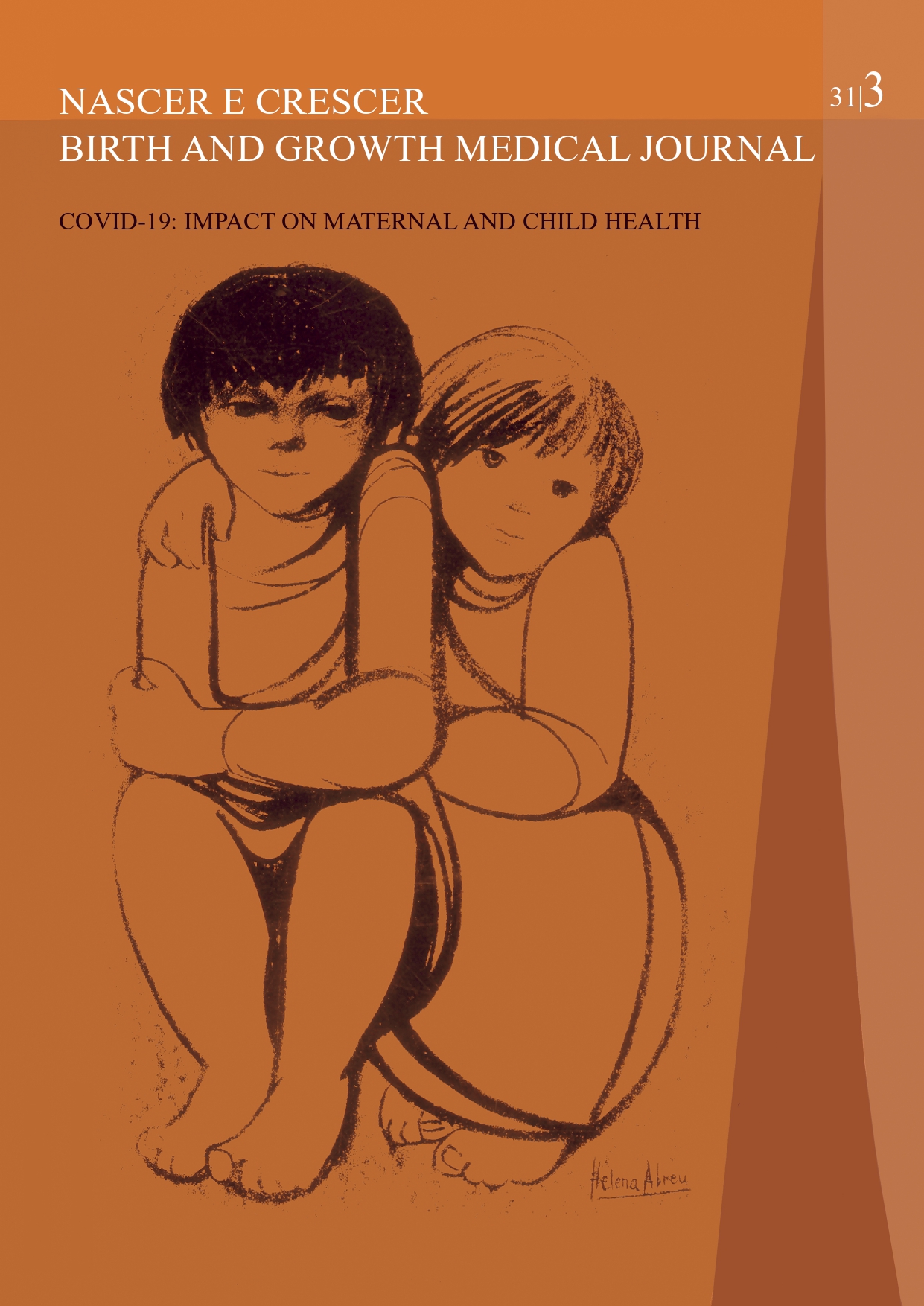BMI changes and its effects on a paediatric obese population in the COVID-19 pandemic
DOI:
https://doi.org/10.25753/BirthGrowthMJ.v31.i3.27726Keywords:
adolescent, COVID-19, comorbidity, children, obesity, overweightAbstract
Introduction: The COVID-19 pandemic represented a major threat to global health. The special circumstances and changes to everyday life due to the worldwide measures had a strong impact, particularly in childhood and adolescent obesity.
We aimed to evaluate the impact on the treatment of obesity and on the expression of comorbidities during the first lockdown.
Methods: Retrospective cohort study of overweight and obese children/adolescents (6-18 years), followed at reference outpatient clinic, since 2018. Anthropometric and biochemical parameters were evaluated.
Results: We studied 71 children/adolescents (52.1% female) with a median age of 10 years. 87.3 % were obese and a family history of obesity was positive in 51.4%.
After home confinement, a significant increase was observed regarding body mass index (p<0.001) and there was worsening of insulin levels (p<0.001), homeostasis model assessment for insulin resistance (p=0.005), and aspartate aminotransferase (p<0.001), but not reaching pathologic levels. Therefore, there was no significant worsening of comorbidities after the lockdown.
Conclusion: During the COVID-19 pandemic, there was a worsening in the magnitude of obesity. However, there was no significant repercussions on its comorbidity, which does not allow to exclude any long-term consequences.
Downloads
References
Sama BK, Kaur P, Thind PS, Verma MK, Kaur M, Singh DD. Implications of COVID-19-induced nationwide lockdown on children’sbehaviorr in Punjab, India. Child Care Health. 2020; 47(1):128-135. doi: https://doi.org/10.1111/cch.12816.
Castellini G, Cassioli E, Rossi E, Innocenti M, Gironi V, Sanfilippo G, et al. The impact of COVID-19 epidemic on eating disorders: a longitudinal observation of pre versus post psychopathological features in a sample of patients with eating disorders and a group of healthy controls. Int J Eat Disord. 2020; 53(11):1855-1862. doi: https://doi.org/10.1002/eat.23368.
Di Renzo L, Gualtieri P, Pivari F, Soldati L, Attinà A, Cinelli G, et al. Eating habits and lifestyle changes during COVID-19 lockdown: an Italian survey. J Transl Med. 2020; 18(1):229. doi: https://doi.org/10.1186/s12967-020-02399-5.
World Health Organization (WHO), Obesity and overweight. Available at https://www.who.int/news-room/fact-sheets/detail/obesity-and-overweight.
Orsi CM, Hale DE, Lynch JL. Pediatric obesity epidemiology. Curr Opin Endocrinol Diabetes Obes. 2011;18(1):14-22. doi: https://doi.org/10.1097/MED.0b013e3283423de1.
Chesi A, Grant SFA. The genetics of pediatric obesity. Trends Endocrinol Metabol 2015;26:711–21. doi: https://doi.org/10.1016/j.tem.2015.08.008.
Rundle AG, Park Y, Herbstman JB, Kinsey EW, Wang YC. COVID-19-Related School Closings and Risk of Weight Gain Among Children. Obesity (Silver Spring). 2020;28(6):1008-1009. doi: https://doi.org/10.1002/oby.22813.
World Health Organization, Tools and toolkits/Child growth standards/ Body mass index-for-age (BMI-for-age). WHO. [captured 2022 06 01]. Available in: https://www.who.int/toolkits/child-growth-standards/standards/body-mass-index-for-age-bmi-for-age.
Expert Panel on Integrated Guidelines for Cardiovascular Health and Risk Reduction in Children and Adolescents; National Heart, Lung, and Blood Institute. Expert panel on integrated guidelines for cardiovascular health and risk reduction in children and adolescents: summary report. Pediatrics. 2011;128(2):13-56. doi: https://doi.org/10.1542/peds.2009-2107C.
García Cuartero B, García Lacalle C, Jiménez Lobo C, González Vergaz A, Calvo Rey C, Alcázar Villar MJ, et al. Cut off points to identify metabolic syndrome in healthy children. An Pediatr (Barc). 2007;66(5):481-90. doi: https://doi.org/10.1157/13102513.
Ten S, Maclaren N. Insulin resistance syndrome in children. J Clin Endocrinol Metab. 2004 ;89(6):2526-39. doi: https://doi.org/10.1210/jc.2004-0276.
Magge SN, Silverstein J, Elder D, Nadeau K, Hannon TS. Evaluation and Treatment of Prediabetes in Youth. J Pediatr. 2020; 219:11-22. doi: https://doi.org/10.1016/j.jpeds.2019.12.061.
VajroMajor P, Lenta S, Socha P, Dhawan A, McKiernan P, Baumann U, et al. Diagnosis of nonalcoholic fatty liver disease in children and adolescents: position paper of the ESPGHAN Hepatology committee. J Pediatr Gastroenterol Nutr. 2012;54(5):700–13. doi: https://doi.org/10.1097/MPG.0b013e318252a13f.
Kubota M. Hyperuricemia in Children and Adolescents: Present Knowledge and Future Directions. J Nutr Metab. 2019 May 2;2019:3480718. doi: https://doi.org/10.1155/2019/3480718.
Braegger C, Campoy C, Colomb V, Decsi T, Domellof M, Fewtrell M, et al; ESPGHAN Committee on Nutrition. Vitamin D in the healthy European paediatric population. J Pediatr Gastroenterol Nutr. 2013; 56(6):692-701. doi: https://doi.org/10.1097/MPG.0b013e31828f3c05.
Valenzise M, D‘Amico F, Cucinotta U, Lugarà C, Zirilli G, Zema A, et al. The lockdown effects on a pediatric obese population in the COVID-19 era. Ital J Pediatr. 2021; 47(1):209. doi: https://doi.org/10.1186/s13052-021-01142-0.
Medrano M, Cadenas-Sanchez C, Oses M, Arenaza L, Amasene M, Labayen I. Changes in lifestyle behaviours during the COVID-19 confinement in Spanish children: a longitudinal analysis from the MUGI project. Pediatr Obes. 2021; 16(4):12731. doi: https://doi.org/10.1111/ijpo.12731.
Gwag SH, Oh YR, Ha JW, Kang E, Nam HK, Lee Y, et al. Weight changes of children in 1 year during COVID-19 pandemic. J Pediatr Endocrinol Metab. 2021; 35(3):297-302. doi: https://doi.org/10.1515/jpem-2021-0554.
Kang HM, Jeong DC, Suh BK, Ahn MB. The Impact of the Coronavirus Disease-2019 Pandemic on Childhood Obesity and Vitamin D Status. J Korean Med Sci. 2021; 36(3):21. doi: https://doi.org/10.3346/jkms.2021.36.e21.
Von Hippel PT, Workman J. From kindergarten through second grade, U.S. Children’s obesity prevalence grows only during summer vacations. Obesity (Silver Spring). 2016;24(11):2296-2300. doi: https://doi.org/10.1002/oby.21613.
Downloads
Published
How to Cite
Issue
Section
License
Copyright (c) 2022 Inês Azevedo, Sara Alves Araújo, Diana Pinto, Joana Silva, Lúcia Gomes, Miguel Costa

This work is licensed under a Creative Commons Attribution-NonCommercial 4.0 International License.
Copyright and Authors' Rights
All articles published in Nascer e Crescer - Birth and Growth Medical Journal are Open Access and comply with the requirements of funding agencies or academic institutions. For use by third parties, Nascer e Crescer - Birth and Growth Medical Journal adheres to the terms of the Creative Commons License "Attribution - Non-Commercial Use (CC-BY-NC)".
It is the author's responsibility to obtain permission to reproduce figures, tables, etc. from other publications.
Authors must submit a Conflict of Interest statement and an Authorship Form with the submission of the article. An e-mail will be sent to the corresponding author confirming receipt of the manuscript.
Authors are permitted to make their articles available in repositories at their home institutions, provided that they always indicate where the articles were published and adhere to the terms of the Creative Commons license.


